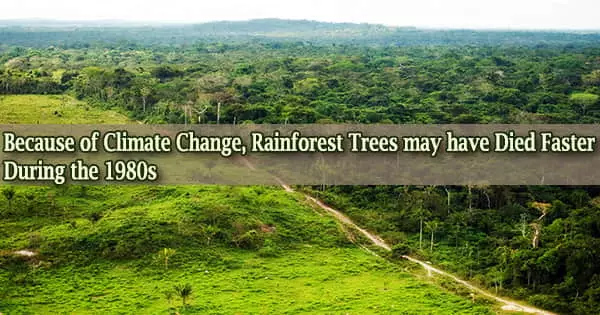According to the findings of a long-term multinational study published today (18th May 2022) in Nature, tropical trees in Australia’s rainforests have been dying at twice the previous rate since the 1980s, presumably due to climate impacts.
The death rates of tropical trees have doubled in the last 35 years, according to this study, as global warming increases the drying power of the atmosphere. Rainforests are one of nature’s most effective climate-change barriers. All forests and other landscapes capture and store carbon dioxide, but tropical rainforests do so more effectively.
Tropical forests are unfortunately being cut down at an alarming rate around the world, releasing more than 1.5 billion tons of carbon dioxide into the atmosphere, accounting for 15% of all human-induced carbon emissions.
As these forests deteriorate, they lose biomass and carbon storage, making it more difficult to maintain global peak temperatures far below the Paris Agreement’s 2°C objectives.
Researchers from the Smithsonian Environmental Research Center, Oxford University, and the French National Research Institute for Sustainable Development (IRD) collaborated on today’s study, which drew on unusually long data sets from Australia’s rainforests.
The average tree death rate in these woods has doubled in the last four decades, according to the study. Researchers discovered that trees are surviving about half as long as they used to, a pattern that was observed across species and locations throughout the region. According to the researchers, the effects can be traced back to the 1980s.
Because rainforests absorb more heat than unforested surfaces, they reduce the Earth’s reflectivity. The heat collected by rainforests is reflected back into the atmosphere when they are cut down. This influences local rainfall amounts and weather patterns, as well as global weather patterns, over big enough areas.
Dr. David Bauman, a tropical forest ecologist at Smithsonian, Oxford, and IRD, and lead author of the study maintains, “It was a shock to detect such a marked increase in tree mortality, let alone a trend consistent across the diversity of species and sites we studied. A sustained doubling of mortality risk would imply the carbon stored in trees returns twice as fast to the atmosphere.”
Dr. Sean McMahon, Senior Research Scientist at Smithsonian and senior author of the study points out, “Many decades of data are needed to detect long-term changes in long-lived organisms, and the signal of a change can be overwhelmed by the noise of many processes.”
Drs Bauman and McMahon emphasise, “One remarkable result from this study is that, not only do we detect an increase in mortality, but this increase seems to have started in the 1980s, indicating the Earth’s natural systems may have been responding to changing climate for decades.”
Nearly 30 million species of plants and animals live in tropical rainforests, all of which rely significantly on one another for existence. Rainforests store and sequester carbon. Forest ecosystems absorb around 2 billion tons of CO2 per year, making them the world’s largest terrestrial carbon sink.
It was a shock to detect such a marked increase in tree mortality, let alone a trend consistent across the diversity of species and sites we studied. A sustained doubling of mortality risk would imply the carbon stored in trees returns twice as fast to the atmosphere.
Dr. David Bauman
Oxford Professor Yadvinder Malhi, a study co-author, points out, “In recent years the effects of climate change on the corals of the Great Barrier Reef have become well known. Our work shows if you look shoreward from the Reef, Australia’s famous rainforests are also changing rapidly.”
Furthermore, the main driving mechanism we detect, the growing drying power of the atmosphere as a result of global warming, shows that similar increases in tree death rates are occurring throughout the world’s tropical forests.
If this is the case, tropical forests may soon become carbon sources, making the task of keeping global warming below 2 degrees Celsius both more important and harder.
Susan Laurance, Professor of Tropical Ecology at James Cook University, adds, “Long-term datasets like this one are very rare and very important for studying forest changes in response to climate change. This is because rainforest trees can have such long lives and also that tree death is not always immediate.”
Recent Amazonian research have also revealed that tropical tree death rates are rising, reducing the carbon sink. However, the reason behind this is unknown.
Tropical rainforests that are still intact are large carbon sinks, absorbing roughly 12% of human-caused carbon dioxide emissions and thus serving as a moderate brake on the rate of climate change.
The study indicates that the key climate driver is the growing drying power of the atmosphere, based on the climate ranges of the tree species with the highest death rates. As the atmosphere heats, it takes more moisture from plants, causing increased water stress and, eventually, death in trees.
When the researchers ran the calculations, they discovered that the loss of biomass caused by the increase in mortality over the decades has not been offset by biomass gains from tree growth and the recruitment of new trees.
This means that the increased mortality has resulted in a net reduction in the forest’s ability to offset carbon emissions. Colleagues from Oxford University, James Cook University (Australia), and other institutions (UK, France, USA, Peru) were part of the research team.
















